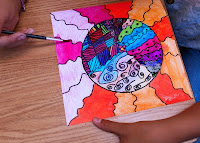After the sixth graders finished their symmetrical paper masks we started their second mask project. We had already looked at a variety of masks from different cultures and discussed the similarities and differences. The first step of this project was to design a mask. The students were encouraged to keep their original design fairly simple. More intricate details could be added later.

The drawings were used as a pattern to transfer the designs onto cardboard. The cardboard shapes were cut out and layered on a background sheet of cardboard to make a mask with a low relief design. After all the pieces were cut out and in place they were glued to the background.
When all the pieces were glued down the students had the option of adding more details, outlines and patterning using lines or dots of glue. The glue needed to be fairly thick. If the glue was too thin and didn't show up well after drying, an additional layer of glue might be needed. The masks were put aside to allow the glue to dry completely.
The following week we were ready for the faux metal painting. The first step was to paint the entire surface with black tempera paint. When it was dry to the touch the students lightly sponged on a layer of gold, bronze or silver tempera paint being careful to leave the recessed areas black.
Final Faux Masks

















































